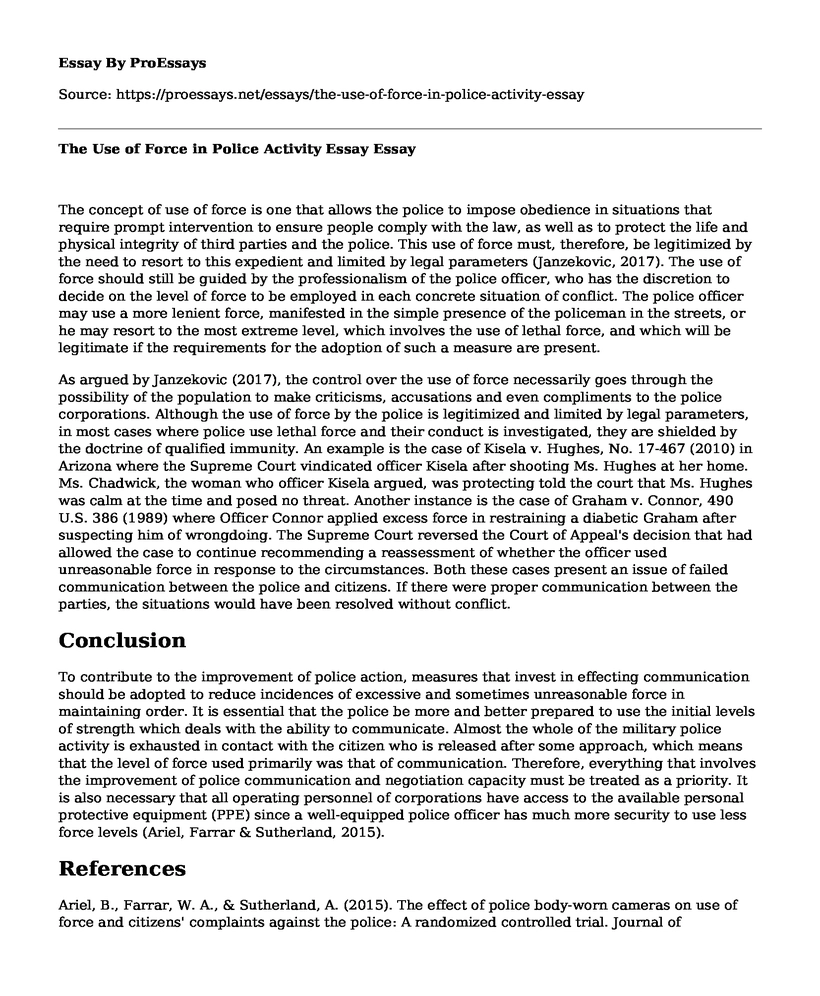The concept of use of force is one that allows the police to impose obedience in situations that require prompt intervention to ensure people comply with the law, as well as to protect the life and physical integrity of third parties and the police. This use of force must, therefore, be legitimized by the need to resort to this expedient and limited by legal parameters (Janzekovic, 2017). The use of force should still be guided by the professionalism of the police officer, who has the discretion to decide on the level of force to be employed in each concrete situation of conflict. The police officer may use a more lenient force, manifested in the simple presence of the policeman in the streets, or he may resort to the most extreme level, which involves the use of lethal force, and which will be legitimate if the requirements for the adoption of such a measure are present.
As argued by Janzekovic (2017), the control over the use of force necessarily goes through the possibility of the population to make criticisms, accusations and even compliments to the police corporations. Although the use of force by the police is legitimized and limited by legal parameters, in most cases where police use lethal force and their conduct is investigated, they are shielded by the doctrine of qualified immunity. An example is the case of Kisela v. Hughes, No. 17-467 (2010) in Arizona where the Supreme Court vindicated officer Kisela after shooting Ms. Hughes at her home. Ms. Chadwick, the woman who officer Kisela argued, was protecting told the court that Ms. Hughes was calm at the time and posed no threat. Another instance is the case of Graham v. Connor, 490 U.S. 386 (1989) where Officer Connor applied excess force in restraining a diabetic Graham after suspecting him of wrongdoing. The Supreme Court reversed the Court of Appeal's decision that had allowed the case to continue recommending a reassessment of whether the officer used unreasonable force in response to the circumstances. Both these cases present an issue of failed communication between the police and citizens. If there were proper communication between the parties, the situations would have been resolved without conflict.
Conclusion
To contribute to the improvement of police action, measures that invest in effecting communication should be adopted to reduce incidences of excessive and sometimes unreasonable force in maintaining order. It is essential that the police be more and better prepared to use the initial levels of strength which deals with the ability to communicate. Almost the whole of the military police activity is exhausted in contact with the citizen who is released after some approach, which means that the level of force used primarily was that of communication. Therefore, everything that involves the improvement of police communication and negotiation capacity must be treated as a priority. It is also necessary that all operating personnel of corporations have access to the available personal protective equipment (PPE) since a well-equipped police officer has much more security to use less force levels (Ariel, Farrar & Sutherland, 2015).
References
Ariel, B., Farrar, W. A., & Sutherland, A. (2015). The effect of police body-worn cameras on use of force and citizens' complaints against the police: A randomized controlled trial. Journal of quantitative criminology, 31(3), 509-535.
Janzekovic, J. (2017). The use of force in humanitarian intervention: Morality and practicalities. Routledge.
Adam L. (April 2018). Supreme Court Rules for Police Officer in Excessive Force Case. Retrieved from https://www.nytimes.com/2018/04/02/us/politics/supreme-court-rules-for-police-officer-in-excessive-force-case.html
Cite this page
The Use of Force in Police Activity Essay. (2022, Sep 22). Retrieved from https://proessays.net/essays/the-use-of-force-in-police-activity-essay
If you are the original author of this essay and no longer wish to have it published on the ProEssays website, please click below to request its removal:
- The Brains Response to Drugs
- Psychologist Understanding of Relapse then Addiction - Research Paper Example
- School Anti-bullying Legislation and Workplace Bullying Rules and Regulations
- Research Paper on Stopping Animal Extinction
- Essay Sample on Conventional or Unconventional Hazard Type
- Essay Example on Mexican Immigrants in US: 11.6M in 2017, 25% in 2020
- Paper Example on Family Struggles with Alcohol Addiction: Effects on All Involved







